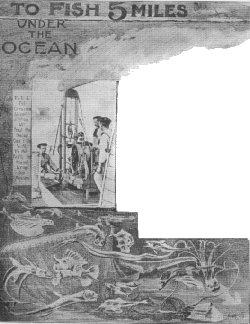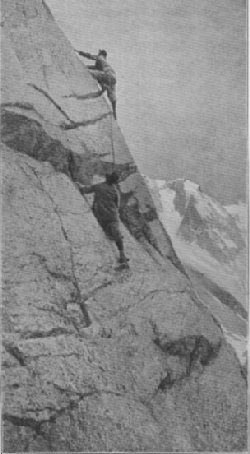|
On the River Elbe an odd method of moving boats is used which is not followed in any other part of the world. The stream is too swift to navigate in the usual way, and hence a chain 290 miles long is laid at its bottom. The boats are 180 feet long and are provided with 200-horse-power engines, which turn a drum fastened on the deck. The chain comes in over the bow, passing along on rollers to the drum, around which it is wound three times. The chain is then carried to the stern. where it drops back into the water. The steamers tow five barges, containing 1,500 tons, and their only means of locomotion is by the chain wound around the drum. which is propelled by the engines on board the boats. THE UNITED STATES GOVERNMENT FISHERIES
Not since the British government cruiser "Gorgon" returned from its voyage in the interest of science, has any vessel been so thoroughly equipped to investigate the depths of the ocean and learn the character of its inhabitants. By the use of the Sigsbee net (invented by Charles D. Sigsbee, Captain United States Navy, late of the lost battleship Maine) it is possible to gather specimens at the astounding depth of five miles, and the construction of this device insures the capture of anything entering it, as it cannot be opened until drawn up to the ship. The value of this vessel's work is incalculable to ichthyologists and navigators, teaching the former new forms of submarine life, and giving the latter soundings of dangerous shoals, hitherto uncharted by hydrographers. The Albatross touched at the Marquesas Group, the Paumotu Islands, the Society Islands, the Tonga Islands and many others. The voyage resulted in the taking of 350 species of fish, of which 70 were new to science. Nearly all were good for food. Most of the fish caught by the natives of the islands are eaten raw. BUYING HUMAN HAIR IN GERMANY Every autumn the hair buyers of Germany start out from Berlin to purchase the luxuriant tresses of women and girls who live in the villages along the Spreewald. In this region the inhabitants, who are of Slavic origin, preserve the language and many of the customs of the ancient vandals. The women and girls wear their heavy masses of silky hair rolled in great coiffures on their heads, and are not averse to being shorn if the buyers offer a figure high enough. The women are fully aware that human hair is a desirable commodity, and they always set a good price for their locks. The buyers are used to the business, however, and are good at driving a bargain, so there is a great deal of haggling before the purchase is finally concluded. The buyers, when commencing operations in a village, always first endeavor to put the inhabitants in a pleasant humor. They invite the villagers to come to the inn, where the former act as hosts, and treat everybody to wine and schnapps. After a day or two spent in establishing themselves as good fellows in the opinions of the townspeople, they begin work. They pick out the girls and women who have the best heads of hair, and offer them a low price for their locks. The women at once name a very exorbitant sum and then the trade is fairly begun. The women talk and argue until finally a compromise is reached, the price is agreed upon, and the village barber trims off the long, wavy locks and turns them over to the buyers. The price of a head of good hair depends upon its quality, luster and color, and upon the age of the person on whom it is grown. The hair of girls between the ages. of 12 and 17 years is deemed most valuable. A good head of hair is worth all the way from $8 to $25. The hair thus obtained is exported all over the world. MOUNTAIN CLIMBING IN SWITZERLAND
Judged by this test, it would seem that, despite all its perils, mountaineering is a less dangerous pastime than many others—say, motoring, or cycling, for example—which are generally accounted much less hazardous. The figures given as to the nationality of those killed during a given period are also rather unexpected. The vast majority, it seems—190, to be precise—were Germans and Austrians, forty-eight were Swiss, twenty-three Italians, eighteen English or American and fifteen French. Most of the accidents occurred, too, in the eastern Alps—which helps, no doubt, to explain the preponderance of the German-speaking climbers among the victims. It is somewhat surprising, none the less, to find that the latter outnumber so largely the English and Americans, and that these together in their turn are hardly more numerous than the French. Doubtless there is something in the explanation that British climbers, as a class, engage good guides, and in addition do their climbing as a rule at the time of the year most favorable for mountaineering; also, perhaps, their exceptional aptitude for the sport may go for something; but still the figures are surprising. What would be interesting to learn would be the proportion of lives lost to the total number of climbers in the case of each nationality. But this information is not supplied. As to the causes of accidents, they are catalogued as follows: 1, neglect to employ good guides; 2, foolhardiness; 3, vanity and the spirit of emulation; 4, carelessness; 5, want of experience; 6, absentmindedness; 7, false economy on food or necessaries; 8, injudicious use of alcohol; 9, climbing at the wrong season—in the early spring or late autumn or winter. A sufficiently comprehensive list, it must be agreed. Yet even so, it is probably not exhaustive. Who can wonder at the perennial fascination of such sport? THE GOVERNMENT OF GREAT BRITAIN |

